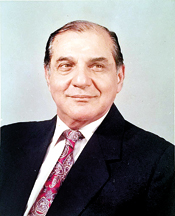Sri Lanka’s spice veteran calls it a day

Mr. Ghulam S. Chatoor
Gulam S Chatoor, 87, one of the pioneers and a veteran in Sri Lanka’s spices industry and exports serving the corporate sector for more than 60 years, has decided to call it a day, announcing his retirement and stepping down from his responsibilities, but will always be available to offer his advice and share his vast knowledge on many disciplines he is well acquainted with.
Mr. Chatoor, Chairman, Saboor Chatoor (Pvt) Ltd, a leading spice exporter of Sri Lanka, is one of the most knowledgeable and respected personalities in the business arena.
Speaking to the Business Times on his retirement, with the love for the whole gamut of the spice export industry and exhorting his desire to offer advice and share his vast knowledge on the spice industry, he indicated that though vast improvements were made to the country’s spice industry, there is ample space to improve and expand.
In this regard he found at least three hurdles – one – lack of availability of spices for which he said that steps should be taken to increase the production of spices in the country to increase exports.
The other point Mr. Chatoor stressed was the highest quality should be maintained and the last point he stressed was that the products should be acceptable to the international market. There are further areas that the industry could be extended to. There are two other export-oriented products – coffee and cocoa – for which the country’s conditions are ideal, he stressed.
He said that efforts should be made to revive the coffee cultivation to a level that it could enter the international market which has a great potential to earn foreign exchange. In the cocoa cultivation, Mr. Chatoor said that there is some sort of cultivation in this regard though the extent of cultivation is not satisfactory, indicating that even to meet the country’s chocolate production, cocoa is imported.
Most of his life has been devoted to this business, since he took over the business from his father, more than 60 years ago. Sri Lanka is the largest cinnamon grower in the world and exports globally.
Sharing his knowledge, he traced how the Colombo 7 ‘Cinnamon Gardens’ came to existence, indicating that this happened during the Dutch era.
He said that cinnamon is native to this country and it grew wildly until the Dutch started growing it as a plantation or a cash crop. Mr. Chatoor said that the Dutch wanted to observe as to how this plant would grow and thus started to grow the plant in the Colombo area which is now popularly known as ‘Kurundu Watte’,
His book titled “The Spic(e)y Story” covers the history of the spice industry with some rare pictures and ample information. Tracing the history of Colombo, he said that Colombo Pettah was a residential area during the Dutch era prior to it becoming a trading hub with diverse races – Sinhalese, Moors, Tamils, Parsees, Dutch, Portuguese, Malays and Afghans.
He went to the extent of tracing the meaning of spices and how it originated from a French word ‘sepice, a derivation from Latin, which is ‘root spec’ in Latin.
Mr. Chatoor founded the ‘Spices & Allied Products Producers & Traders’ Association’ in 1984 to represent matters to the state authorities pertaining to the spice industry and exports.
He was Chairman, Ceylon Chamber of Commerce from 1986-1989 and continued to be associated with the Ceylon Chamber of Commerce by serving as the representative of the Spices & Allied Products Producers & Traders’ Association (SAPPTA) since 1975.


